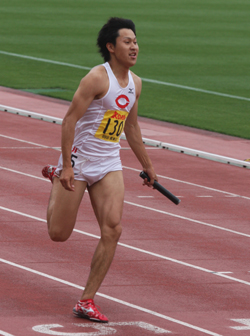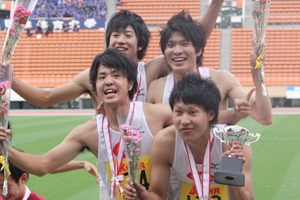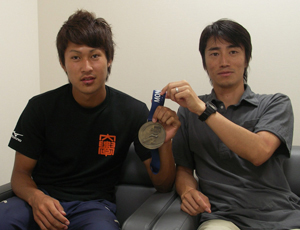Top>HAKUMON Chuo [2012 Summer Issue]>[London Olympics Feature: Commemorating participation and celebrating medals] The first student to compete in a track and field Olympic event in 48 years Olympics created by continual coaching from high school
 Index
Index
[London Olympics Feature: Commemorating participation and celebrating medals]
The first student to compete in a track and field Olympic event in 48 years
Olympics created by continual coaching from high school
Shota Iizuka (3rd year student in the Faculty of Law; from Fujieda Meisei Senior High School, Shizuoka Prefecture)
Tetsuya Tateno (3rd year student in the Faculty of Commerce; from
Tokyo Ikubunkan Institute of Education, Ibaraki Prefecture)
On June 11th, Shota Iizuka (3rd year student in the Faculty of Law; from Fujieda Meisei Senior High School, Shizuoka Prefecture) and Tetsuya Tateno (3rd year student in the Faculty of Commerce; from Tokyo Ikubunkan Institute of Education, Ibaraki Prefecture) of Chuo University were selected to represent Japan in track and field events of the London Olympics.
The selection of Chuo University students to compete in Olympic track and field events is a monumental achievement, and is the first time in the 48 years since the Tokyo Olympics. In addition to conveying the joy of the two athletes, we talked with track and field coach Tadashi Oguri about the two athlete's strengths and highlights of their events. This article is also a guide to viewing the Olympics.
Emotions which can't be conveyed through email

Coach Oguri received the happy news from Osaka about the two Olympic athletes. The Japan Track & Field Championships were held in Osaka until the 10th of June and a meeting to select Olympic athletes had been held that day. Shota was selected men's 200 meter dash and relay, while Tetsuya was chosen for the men's 400 meter hurdles.
Coach Oguri quickly sent an email to the two athletes.
"You've been selected for the Olympics. Congratulations!"
At the championships, Shota placed 4th in the 100 meters and 2nd in the 200 meters. Tetsuya finished 3rd in the 400 meter hurdles.
Although the two athletes had been considered a lock for the Olympic due to their placing and past record, everyone had been eagerly awaiting the official decision. The two athletes briefly spoke with Coach Oguri by telephone and expressed their feelings of gratitude. Then, they took their good news with them back to the Higashi-Toyoda Dormitory.
Following the brief telephone conversation, Coach Oguri was unable to contact the athletes. Their phones were always busy. It seems that the Olympic selection had suddenly made them busy. They were sharing their joy by speaking directly on the telephone.
Victory of coordinated instruction

Shota won the 200 meter dash at last season's Japan Intercollegiate Championships. This season, he won the 100 meter dash at the Kanto Intercollegiate Track & Field Championships. At the 2010 World Junior Track & Field Championships, he was the first Japanese athlete to win a gold medal in the 200 meters. As a result of such performances, there were great expectations for his future.
Instructor Tsuneyasu Sato, the track and field coach at Shota's alma mater Fujieda Meisei Senior High School, has a deep connection with Chuo University. He was the former teacher of Coach Oguri, who was born in Hamamatsu City, and the two have been acquaintances since long ago. Coach Sato is able to directly convey his principles for strengthening and instructing athletes directly to Coach Oguri. The result is continuous coaching from high to university, allowing athletes to proceed smoothly on the correct path.
In the world of sports, the proverb of too many cooks spoil the broth continues to ring true. There are many bad examples of athletes becoming confused when they are taught differing principles by multiple coaches, all of who have their own independent opinion. In these terms, the system of continuous instruction at Chuo University is a big advantage.
Tetsuya placed 2nd in the 400 meter hurdles at the Kanto Intercollegiate Track & Field Championships which were held in May. When Tetsuya started competing in combined events during his first year of high school, he posted the 2nd best performance in history. In his second year of high school, he showed his outstanding athletic ability by recording the best performance in history. These combined events are based on the decathlon, which is said to determine the king of athletes. Two of the events have been removed to make the combined events suitable for high school students (100 meters, long jump, shot put, 400 meters, 110 meter hurdles, high jump, javelin and 1500 meters).
Tetsuya's high school coach also has a deep relationship with Chuo University. An Olympic athlete cannot be made in a single day. It is a great achievement made possible through cooperation.
-
"My goal is to post a personal best time at the Olympics and proceed to the semifinals. In the semifinals, I hope to compete with the world's top athletes and see how far my ability will take me."
(Personal best time in 200 meters: 20.45 seconds) -
"I think that my times can still get better. I hope to post a time of about 49.2 or 49.3 seconds. I will continue to train as hard as possible so that I can give my best performance at the Olympics."
(Personal best time in 400 meter hurdles: 49.49 seconds)
Competing with the world's top athletes! Shota Iizuka
My times can still get better! Tetsuya Tateno
Coach Tadashi Oguri of Chuo University discusses important points of Shota's and Tetsuya's races.
Shota Iizuka (200 meters)
Spectators should pay close attention to how Shota speeds up in the second half of races. In the case of the 100 meter dash, Shota best running takes place after 60 meters. For the 200 meter dash, he runs best from the 120 meter to 180 meter distance.
In many races, Japanese athletes take off from the start and excite everyone only to fatigue later in the race.
However, Shota doesn't panic even if his start is poor. He recovers ground in the second half of the race. During practice, we consider the total distance of 100 meters and 200 meters. The athlete who crosses the finish line even 1 millimeter sooner is the winner. Since high school, Shota has repeatedly practiced running while relaxed.
Trying too hard creates bad results. Each time Shota ran a race, he has focused on relaxing in order to eliminate tension. He is very calm now and has become mentally strong.
Shota is a big runner at 185 centimeter tall. It is difficult for him to turn corners once he has reached top speed. In the 200 meters, lanes 6 to 8 are best for him because the turns are gentle. This is another important point. He started in lane 8 when he finished 2nd in the 200 meters at the Japan Track & Field Championships.
Tetsuya Tateno (400 meter hurdles)
Despite having a stern expression and being strongly motivated, Tetsuya is a dexterous man. In the 400 meter hurdles, runners jump over 10 hurdles. Runners usually take about 14 steps between hurdles. Sometimes this increases to 15 steps.
Although many runners panic once they have lost their rhythm, Tetsuya is calm even if he takes 15 steps. He simply goes back to 14 steps between the next hurdles. He can change his number of steps back and forth. Even more, he can jump off a hurdle off of either leg. This is why I call him dexterous.
Even in a pinch, Tetsuya has good technique to overcome it and is mentally strong. He runs evenly and with a good rhythm. Will he take 14 or 15 steps? Will he jump off his right of left leg? This is something that spectators should watch carefully.

- Research Activities as a Member of Research Fellowship for Young Scientists (DC1), Japan Society for the Promotion of Science (JSPS) Shuma Tsurumi
- Important Factors for Innovation in Payment Services Nobuhiko Sugiura
- Beyond the Concepts of Fellow Citizens and Foreigners— To Achieve SDGs Goal 10 “Reduce Inequality Within and Among Countries” Rika Lee
- Diary of Struggles in Cambodia Fumie Fukuoka
- How Can We Measure Learning Ability?
—Analysis of a Competency Self-Assessment Questionnaire— Yu Saito / Yoko Neha - The Making of the Movie Kirakira Megane








